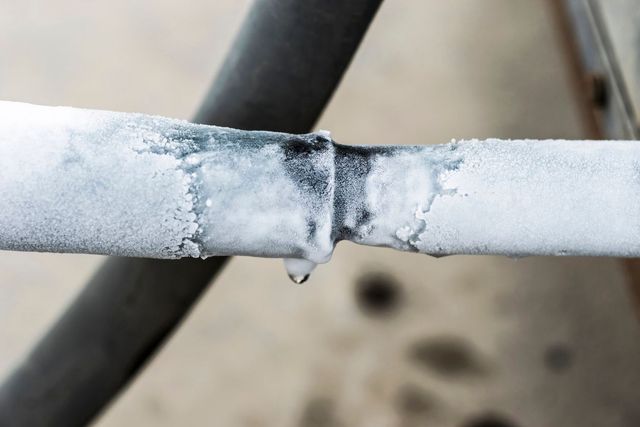In this article below you can discover a bunch of extremely good guidance with regards to Have a Frozen AC Line? Here’s How to Fix It.

Intro
Uncovering that your air conditioner pipeline is iced up can be worrying, especially during warm summertime when you depend on your air conditioning unit the most. Comprehending what to do in such a situation is critical to stop additional damage to your air conditioning system and guarantee your comfort indoors.
Recognizing the Causes
Several factors can add to the cold of an air conditioning pipe. Understanding these causes can assist you resolve the problem efficiently.
Lack of Airflow
One typical cause of an icy air conditioning pipeline is inadequate air flow. When the air movement over the evaporator coil is restricted, it can trigger the coil to drop below freezing temperature, bring about ice formation on the pipe.
Reduced Refrigerant Levels
Insufficient cooling agent levels in your a/c system can likewise cause an icy pipeline. Low refrigerant levels can create the stress in the system to drop, causing the cold of wetness on the evaporator coil.
Winter Conditions
In colder climates, freezing temperature levels outside can add to the cold of air conditioning pipelines. If your AC system is not properly shielded or if there are leakages in the ductwork, cool air can infiltrate the system, causing the pipe to ice up.
Dirty Air Filters
Unclean or blocked air filters can restrict air flow in your air conditioning system, resulting in different concerns, including a frozen pipeline. It's important to replace or cleanse your air filterings system on a regular basis to make sure appropriate air flow and protect against ice accumulation.
Indicators of a Frozen Air Conditioner Pipe
Identifying the indicators of an icy a/c pipeline is vital for timely action.
Decreased Airflow
If you discover a significant decline in air movement from your vents, it can show a frozen pipe.
Ice Buildup on the Pipe
Noticeable ice accumulation on the refrigerant line or the evaporator coil is a clear indicator of an icy AC pipeline.
Odd Sounds from the Unit
Uncommon audios, such as hissing or bubbling, originating from your air conditioner unit can signify that there's ice present on the pipeline.
Immediate Actions to Take
When confronted with an icy a/c pipeline, it's important to act promptly to prevent additional damage to your cooling system.
Switching off the air conditioner
The initial step is to turn off your air conditioning system to prevent the system from running and exacerbating the problem.
Looking for Blockages
Examine the location around the interior unit for any kind of obstructions that might be obstructing air flow, such as furnishings or drapes.
Thawing the Pipe
You can utilize mild methods like positioning towels taken in cozy water around the frozen pipeline to aid thaw it slowly.
Preventive Measures
Taking safety nets can help avoid future events of a frozen AC pipeline.
Routine Maintenance Checks
Schedule normal maintenance get in touch with a professional HVAC service technician to guarantee that your AC system is running efficiently.
Altering Air Filters
On a regular basis change or cleanse your air filters to stop air movement restrictions and keep ideal performance.
Protecting Exposed Pipes
If your air conditioner pipelines are exposed to cool temperatures, consider insulating them to stop cold throughout winter months.
Seeking Professional Help
If DIY approaches fall short to resolve the issue or if you're not sure about just how to proceed, it's ideal to look for aid from a qualified HVAC technician.
When DIY Methods Fail
If your attempts to thaw the pipe or address other issues are not successful, it's time to call an expert.
Significance of Hiring a Professional HVAC Technician
A licensed HVAC technician has the experience and tools essential to detect and repair issues with your AC system securely and effectively.
Final thought
Dealing with a frozen air conditioner pipeline can be a discouraging experience, but recognizing exactly how to react can aid minimize damages and bring back comfort to your home. By recognizing the causes, identifying the indications, and taking punctual action, you can effectively attend to the problem and prevent future incidents.
G UP? HOW TO FIX IT?
It happens all over America. And the rest of the world probably. It’s the hottest day ever and for some darn reason your AC isn’t cooling the house. You fiddle with the thermostat to try and fix the problem. Nada. All you can do now is go outside and check the AC unit. You make your way there and find your air conditioner unit is frozen! But how?
In this post we’ll cover how you can tell that your air conditioner has frozen (other than the obvious reasons), what could have caused the freeze, and some of the things you can do about your AC freezing up. And if you have a frozen heat pump condenser, read our blog about it to learn what to do! But remember, it is always best to avoid your AC freezing up with an AC tune up. And if you are moving into a home, it's critical to get HVAC inspection so that you are aware of an AC problems before you move in.
Keep reading and you may be able to fix the frozen AC yourself. If you can’t, call an HVAC specialist. If you live in Maryland, call SuperTech HVAC for AC repair. We’ll take care of it.
How Does An Air Conditioning Unit Work?
How you probably imagine an AC works is wrong. Contrary to popular belief, an AC system does not inject cool air into a building. Instead, it removes the heat from inside and transfers it outside. Cool huh? (Pun intended).There are 4 major components among the 3 stations of an air conditioning system: the evaporator coil, the compressor, the condenser, and the refrigerant – a special chemical that links everything together through a closed loop system.
Station 1:
Warm indoor air is sucked into the return vent, through a filter, and blows over the evaporator coil. The heat is absorbed into the cold refrigerant, turning it from liquid to gas. The air, which is now cool, is blown back into the home to areas that your thermostat, i.e. you, has decided.
Station 2:
The refrigerant makes its way outside the house to the compressor, which squeezes the warm refrigerant, raising its gaseous temperature even more.
Station 3:
When the super hot vapor refrigerant reaches the condenser, the last step, the heat is expelled and absorbed into the outdoor air. The refrigerant instantly cools, which changes it from gas back to liquid form. The cold liquid refrigerant is now ready to return to station 1 and repeat the process.
Is Your AC Freezing Up? Here Are The Signs:
As you may have guessed, your air conditioner unit freezing up on a hot day is not normal.
If this happens, there's no need to panic. Often the issue can be solved with a little troubleshooting. If the AC unit is left frozen for too long however, you may find yourself with a bigger problem.
First things first, how do you know your AC is frozen?
Well, the obvious sign is the ice on your refrigerant line-set pipe. Simply check between your outdoor AC unit and your home's exterior wall to see whether your AC line frozen.
You might also have a frozen evaporator coil. This one's not as easy to check. You'll need to open a panel on the indoor unit to inspect. Don't do this unless you're handy. If you aren't, call an HVAC pro like SuperTech HVAC or you may damage something in the process.

I recently found that blog post about Air Conditioner Frozen? How To Fix your Frozen AC Line while doing a search on the internet. Sharing is good. Helping others is fun. Thanks for your time spent reading it.
Request Appointment